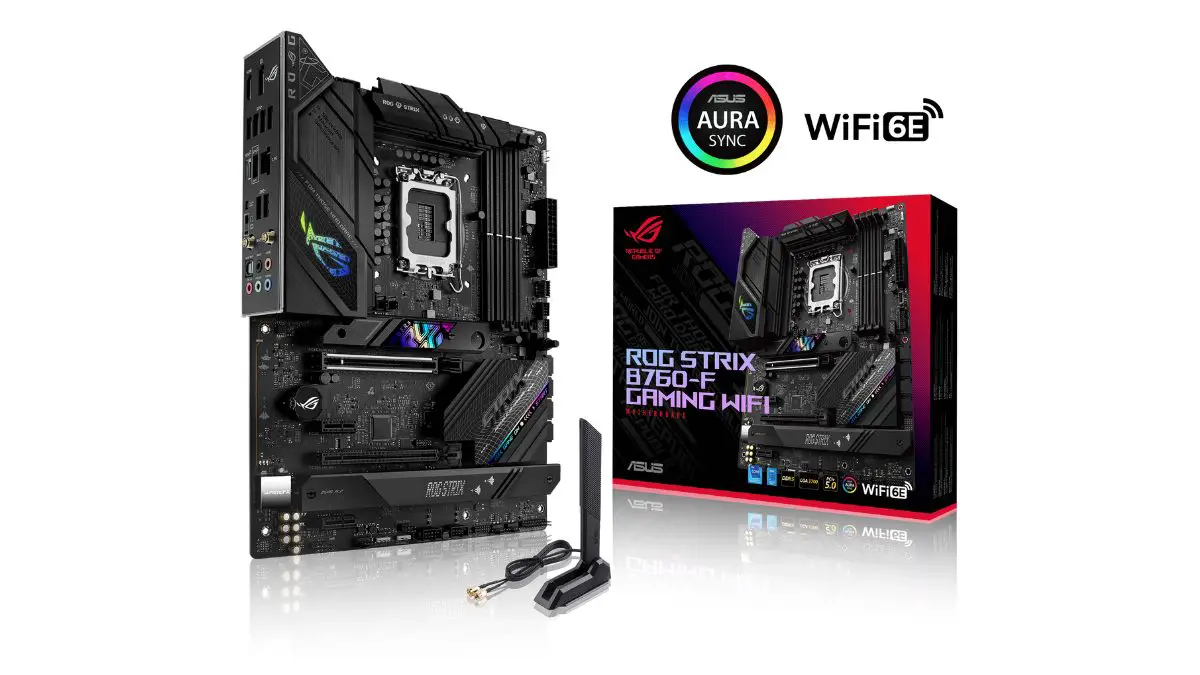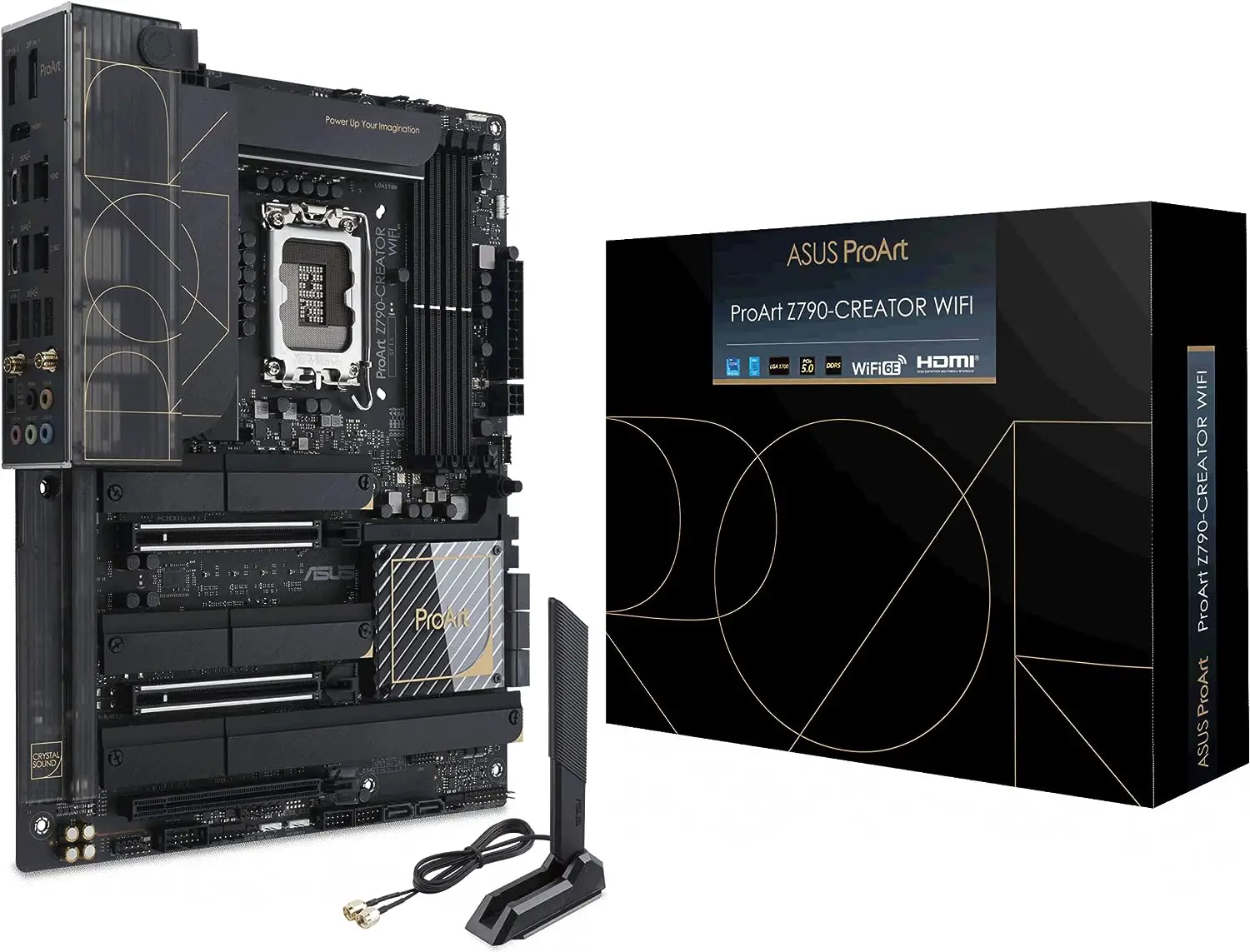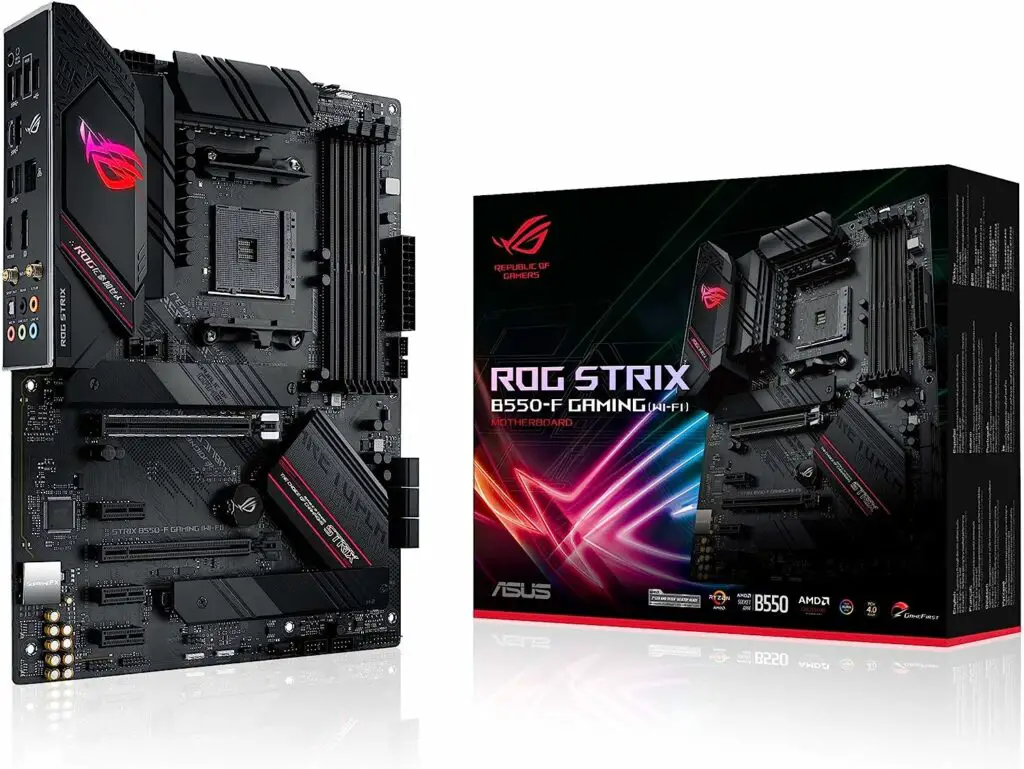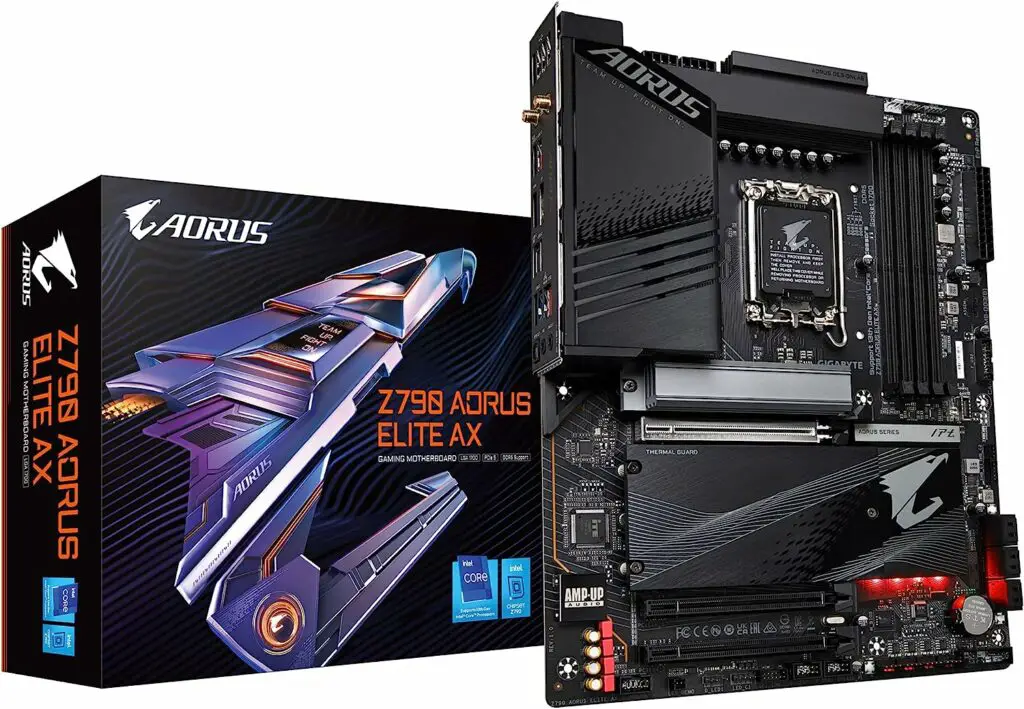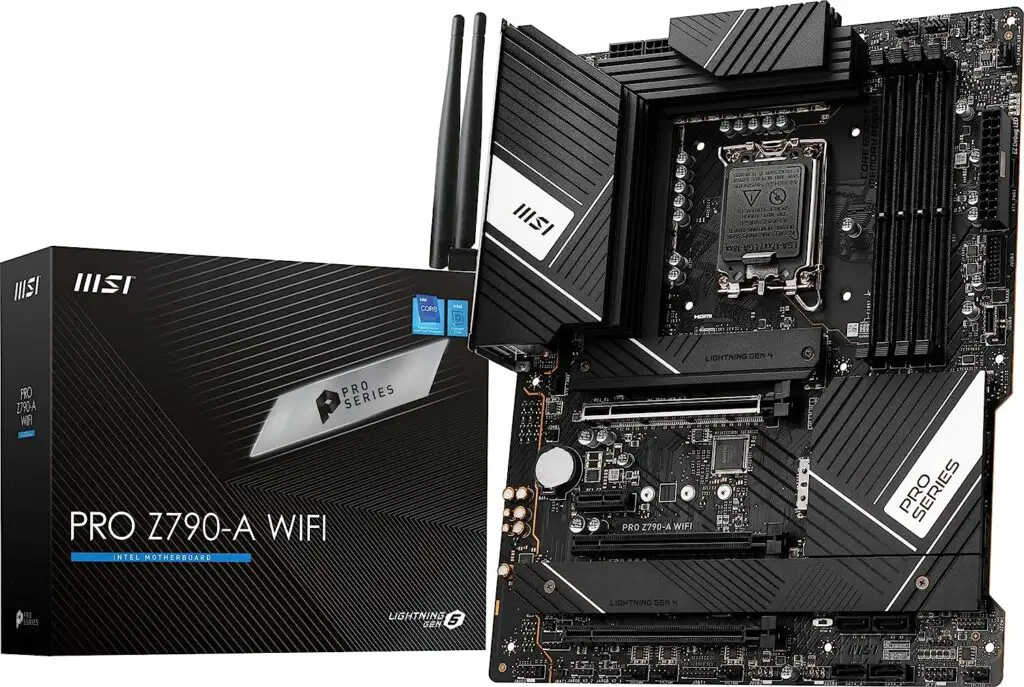Grab a good motherboard for your next video editing workstation build on the basis of form factor, budget, generation and CPU compatibility.
The motherboard can have an impact on video editing performance, although it is just one component among several that contribute to overall system performance.
The motherboard plays a crucial role in connecting all the hardware components of your computer, including the CPU, RAM, GPU, storage devices, and more.
A well-designed motherboard with support for the latest technologies can lead to better overall system stability and data transfer speeds, which can indirectly impact video editing performance.
Regarding 4K video editing, having the right motherboard is crucial for getting the job done efficiently and effectively. A high-quality motherboard can help ensure smooth performance, fast processing speeds, and the ability to handle even the most demanding editing tasks.
No matter, you’re looking to build or upgrading PC for video editing, a good motherboard is important.
Whether you’re a professional editor or just starting out, investing in the right motherboard can make a big difference in the quality and speed of your work.
Here is a recommended computer spec for video editing:
- CPU: Intel Core i7 or AMD Ryzen 7
- RAM: 32GB
- Graphics card: NVIDIA GeForce RTX 3070 or AMD Radeon RX 6700 XT
- Storage: 1TB SSD
- Display: 4K monitor with at least 90Hz refresh rate
- Audio: Sound card with 5.1 surround sound
- Cooling: Liquid cooling system
This spec will allow you to edit even the most demanding video projects without any problems. However, if you are on a budget, you can still get a good computer for video editing with a lower spec. Just make sure that you have at least 16GB of RAM and a good graphics card.
Our recommended list of the Best Motherboard for video Editing
- ASUS ProArt Z790-Creator WiFi 6E : Overall Best For Video Editing
- ASUS ROG Strix B550-F Gaming Motherboard
- GIGABYTE Z790 AORUS Elite Gaming Motherboard
- MSI PRO Z790-A WiFi ProSeries Motherboard
- ASUS Prime X670E-PRO Motherboard
- MSI MAG B650 Tomahawk WiFi Gaming Motherboard
Motherboard Requirements for Video Editing
- ATX Form Factor
- B550 chipset to Z790
- At least 4 memory slot for up to 128 GB of RAM
- Support 2 M.2 slots and 6 SATA ports
- Support WiFi 6 ( 802.11ax) connectivity
- PCIe 4.0 or 5.0
Video Editing vs Photo Editing
Video editing and photo editing are both creative processes that involve manipulating visual content, but they have some key differences. Video editing involves working with moving images and audio to create a final product, such as a movie, TV show, or online video. Video editing requires a lot of processing power and memory, as well as specialized software and hardware to handle large file sizes and complex editing tasks.
- On the other hand, photo editing involves working with still images to adjust color, brightness, contrast, and other elements to create a final product. Photo editing software, such as Adobe Photoshop, is widely used in the industry, and while it does require some processing power, video editing is more demanding.
- Video editing can take much longer than photo editing, as it involves multiple audio and video layers and often requires more complex editing techniques. Photo editing can be completed relatively quickly, depending on the project’s complexity.
- Video editing often involves a team of directors, editors, and sound technicians working together to create the final product. Photo editing can be done by an individual, but it can also involve collaboration with photographers, graphic designers, and other professionals.
- Regarding hardware requirements, video editing requires a more powerful computer system than photo editing. As it involves working with files and more complex software. A high-end graphics card, fast processor, and plenty of memory are essential for video editing, while photo editing can be done on a more modest system. Video and photo editing are important aspects of the creative industry and require different skills and tools to create a final product.
1. ASUS ProArt Z790-Creator WiFi 6E : Overall Best For Video Editing
Our top pick for the Overall Best motherboard For Video Editing is the ASUS ProArt Z790-Creator WiFi 6E.
The ASUS ProArt Z790-Creator WiFi 6E motherboard is a high-performance ATX motherboard designed specifically for content creators and video editing enthusiasts. It is equipped with a range of features to enhance video editing capabilities and overall system performance.Key Features:
Designed for Intel 12th and 13th Gen Core processors, ensuring compatibility with the latest CPU technology. This motherboard supports PCIe 5.0 for faster data transfer speeds and DDR5 memory for improved system performance.
It has two Thunderbolt™ 4 ports (USB4® compliant) that can provide up to 40 Gbps of bi-directional data transfers. You can connect to all your content creation gadgets and devices, such as pen displays, tablets, cameras, external drives, and monitors with ease. You can also daisy-chain up to five devices and support one 8K or two 4K displays via the Thunderbolt 4 ports.
Pros
- Robust power
- PCIe 5.0 / DDR5
- Effective thermal design
- Advanced security features
Cons
- Limited compatibility
- Higher cost
2- ASUS ROG Strix B550-F Gaming Motherboard
If you’re a video editor looking for a powerful and feature-packed motherboard to take your editing game to the next level, look no further than the ASUS ROG Strix B550-F Gaming ATX Motherboard. Its Supports both 3rd Gen and Zen 3 Ryzen processors. This means you can choose the processor that best suits your needs and budget without worrying about compatibility issues. In addition, the motherboard supports PCIe 4.0, which offers lightning-fast data transfer speeds and can greatly improve the performance of your editing software.
The B550-F Gaming (WiFi 6) also features a 2.5Gb LAN port, allowing fast and stable internet connectivity. This is particularly important for video editors who upload and download large files quickly and efficiently. The motherboard also supports BIOS Flashback, which makes it easy to update your BIOS without having to boot up your system.
For display connectivity, the ASUS ROG Strix B550-F Gaming (WiFi 6) offers HDMI 2.1, which supports high-resolution and high-refresh-rate displays, ensuring you get the best possible visuals when editing your videos. Also, thanks to the features of an Addressable Gen 2 RGB header and Aura Sync technology. This allows you to customize the lighting on your motherboard and synchronize it with other Aura Sync-enabled components for a fully immersive experience.
For anyone who wants the best possible performance for their system, this motherboard video range of impressive attributes and cutting-edge technologies make it a top choice for video editor users. So whether you’re a professional video editor or just starting out, the B550-F Gaming (WiFi 6) will meet your needs and exceed your expectations.
Comparison
Comparing this high-performance ASUS ROG Strix B550-F to ASUS ROG Strix B450-F, have almost the same features, but ROG B550-F is impressive in performance. Because this board offers 1x Intel 122-V 2.5 Ethernet, and 5 x Gold-plated audio jacks, almost amazing ability offers a WiFi module (WiFi 802.11) and Bluetooth v5.0. With the normal price For video editing, the ASUS ROG Strix B550-F is good.
Pros
- Ideal for high-performance PC build
- Optimize thermal solution
- Support Addressable Gen 2 RGB header
- Comes with fast connectivity options
Cons
- A Little pricy
3- GIGABYTE Z790 AORUS Elite Gaming Motherboard
For video editing professionals, selecting the right board with the high brand is relatively easy because The GIGABYTE Z790 AORUS Gaming Motherboard is an excellent choice for your video editing system. This impressive board is packed with cutting-edge technologies that make it a top choice for those looking for a high-performance system to handle demanding gaming and video editing tasks.
Firstly support LGA 1700 and Intel Z790 processors, which offer top-of-the-line performance and compatibility with the latest video editing software. In addition, the motherboard supports DDR5 memory, which offers faster speeds and improved performance over previous generations of DDR memory.
For storage, the Z790 AORUS Elite AX boasts quad M.2 slots, allowing for installing lightning-fast NVMe SSDs, improving read and write speeds, and making data transfer more efficient. The motherboard also supports PCIe 5.0, which offers double the bandwidth of PCIe 4.0, making it ideal for handling large video files and data transfer.
The Z790 AORUS Elite AX also features USB 3.2 Gen2X2 Type-C ports, which offer fast data transfer speeds and convenient connectivity for peripherals. In addition, the motherboard also comes equipped with Intel WiFi 6E and 2.5GbE LAN, providing fast and stable internet connectivity for seamless file transfers and video streaming.
For ease of use, the Z790 AORUS Elite AX heaves Q-Flash Plus features, allowing for easy BIOS updates without needing a CPU or memory. The motherboard also includes a PCIe EZ-Latch, making installing and removing devices without tools or screws easy. So whether you’re a professional editor or just starting out, the Z790 AORUS Elite AX will meet your needs and exceed your expectations.
Comparison
Comparing this GIGABYTE Z790 AORUS Elite AX to GIGABYTE Z690 AORUS Elite AX, both have impressive features. But the New latest Z790 chipsets motherboard offers too much high performance and the latest features. If you are not budget conscious and want a high-grade motherboard for video editing, go with the GIGABYTE Z790 AORUS. Because it offers a DDR5 memory module, WiFi 6E, PCIe 5.0, and a wide range of fast connectivity options. If you want a mid-range price motherboard, look at the GIGABYTE Z690 AORUS Elite AX for this.
Pros
- Solid performance
- Support 16+1+2 power phase
- EZ-Latch on PCIe Slot
- Good enough USB ports
- Quick Plash Plus Button
- Support Bluetooth
- Overall Good performance
Cons
- Expensive
- No Debug LED
4- MSI PRO Z790-A WiFi ProSeries Motherboard
The MSI PRO Z790-A WiFi ProSeries Motherboard is the latest addition to high-performance motherboards designed specifically for video editing professionals. With its Support for 12th/13th Gen Intel Processors, LGA 1700 socket, and ATX form factor is also the perfect choice for video editing games to the next level, and you will get the full potential of components performance.
One of the most impressive features of the MSI PRO Z790-A WiFi ProSeries Motherboard is its Support for the latest 12th/13th Gen Intel Processors. These processors offer unparalleled performance and are designed to handle the most demanding video editing tasks. With this motherboard, you can be sure you have the power to edit high-quality videos quickly and efficiently.
Another key feature of the MSI PRO Z790-A WiFi ProSeries Motherboard is its Support for DDR5 memory. The DDR5 memory is faster and more efficient than its predecessors, so your video editing software will run more smoothly and quickly. This can save you valuable time and improve your workflow.
In addition to its impressive performance features, the MSI PRO Z790-A WiFi ProSeries Motherboard has built-in WiFi 6E and 2.5Gbps LAN. These connectivity options provide fast and reliable internet access, essential when transferring large video files. In addition, the motherboard includes USB 3.2 Gen2 ports for fast data transfer and M.2 slots for lightning-fast NVMe SSDs.
One of the best abilities of the ProSeries Motherboard is its Support for PCIe 5.0. This technology provides double the bandwidth of PCIe 4.0, so you can transfer data even faster. This can be a game-changer when working with large video files or rendering complex 3D animations.
Overall, the MSI PRO Z790-A WiFi ProSeries Motherboard is a top-of-the-line choice for video editing professionals. Its range of features takes your video editing performance to the next level. With this motherboard, you can be sure you have the power and performance to quickly and efficiently create high-quality videos.
Comparison
We compare this MSI PRO Z790-A ProsSeries motherboard to its compatible MSI MAG Z790 Tomahawk WiFi motherboard. Both motherboards have the same features and performance, just a difference between prices. MSI PRO Z790-A ProsSeries has less price, and high and normal budget users easily buy this board compared to MSI MAG Z790 Tomahawk WiFi motherboard because this is too expensive.
Pros
- A great option for Intel’s latest 13th Gen processors
- Offers DDR5 memory module
- ATX Form Factor
- Support WiFi 6E
- Solid performance
- Great for business, like video editing, photo editing, etc
Cons
- Expensive for some users
5- ASUS Prime X670E-PRO Motherboard
The ASUS Prime X670E-PRO ATX Motherboard is ideal for video editing professionals looking for a high-performance motherboard that can handle the latest AMD 7000 series processors. Its range of features, including PCIe® 5.0, DDR5, 4X M.2 Slots, USB 3.2 Gen 2×2 Type-C®, USB4® Support, WiFi 6E, and 2.5G Ethernet, this motherboard is designed to take your video editing to the next level.
Thanks to its Support of Socket AM5 (LGA 1718) and also support PCIe® 5.0. This technology provides double the bandwidth of PCIe® 4.0, so you can transfer data even faster. This can be a game-changer when working with large video files or rendering complex 3D animations.
The ASUS Prime also comes with Support for DDR5 memory. DDR5 memory is faster and more efficient than its predecessors, so your video editing software will run more smoothly and quickly. This can save you valuable time and improve your workflow, as it comes with 4X M.2 Slots. These slots allow you to install multiple high-speed NVMe SSDs, which can significantly improve your system’s performance when working with large video files.
Additionally, the motherboard comes with USB 3.2 Gen 2×2 Type-C® and USB4® Support, which enables lightning-fast data transfer speeds and connectivity with the latest peripherals. The motherboard also includes built-in WiFi 6E and 2.5G Ethernet connectivity options, which provide fast and reliable internet access. This is crucial when transferring large video files or when collaborating with others remotely.
Comparison
The ASUS Prime X670E-PRO WiFi Socket AM5 is a high-performance motherboard for new latest PC components and offers many impressive features. If you Compare ASUS Prime X670E-PRO to its ASUS Prime X370-PRO motherboard for video editing, then the X670E-PRO is an excellent choice; it supports a DDR5 memory module with 64 GB maximum RAM and offers 3 extra M.2 Ports and 1 Slot PCIe x4.
Pros
- Offers 3 m.2 slots
- Get a Wide range of connectivity
- Features an ATX form Factor
- Uses the X670E chipsets with Intel LGA 1718 socket and AMD AM5
Cons
- Does not have any lighting feature
6- MSI MAG B650 Tomahawk WiFi Gaming Motherboard
The MSI MAG B650 Tomahawk WiFi Gaming Motherboard is a high-performance motherboard designed for video editing professionals who demand the best. With its AMD AM5 socket, ATX form factor, DDR5 memory support, PCIe 4.0, M.2 slots, SATA 6Gb/s, USB 3.2 Gen 2, HDMI/DP ports, WiFi 6E, and Support for AMD Ryzen 7000 Series Desktop Processors, this motherboard has everything you need to take your video editing to the next level. In addition, Support for PCIe 4.0, This technology doubles the bandwidth of PCIe 3.0, allowing you to transfer data even faster.
Moreover, This is especially useful when working with large video files or rendering complex 3D animations. The motherboard also comes with M.2 slots, which allow you to install high-speed NVMe SSDs, providing even faster read and write speeds. The MSI MAG B650 Tomahawk WiFi Gaming Motherboard also supports DDR5 memory, which is faster and more efficient than DDR4 memory. This means your video editing software will run more smoothly and quickly, improving your workflow and saving you valuable time.
The motherboard also features WiFi 6E, which provides faster and more reliable wireless connectivity. This is essential when collaborating remotely or when transferring large video files. Additionally, the motherboard comes with HDMI/DP ports, allowing you to connect multiple monitors and work on multiple projects simultaneously. Regarding connectivity, it offers USB 3.2 Gen 2 ports, which provide high-speed data transfer and charging capabilities from one device to another.
It also has SATA 6Gb/s ports for connecting additional storage devices. Regarding performance, it especially comes with the latest processor connectivity to handle the latest AMD Ryzen 7000 Series Desktop Processors. These processors provide incredible performance for video editing tasks, allowing you to render videos faster and work more efficiently. As a result, MSI MAG B650 Tomahawk WiFi Gaming Motherboard is an excellent choice for video editing professionals who demand the best performance and features.
Comparison
The MSI MAG B650 Tomahawk Gaming Motherboard compared to its previous version MSI MAG B450 Tomahawk MAX. Then the MAG B650 is a good option for video editing, gaming, and other components. Because it offers wireless LAN Integrated, 2 Ports M.2, 1 Onboard USB 3.2 Gen 2.
Pros
- Nice Military inspired looks
- WiFi 6E
- Nice Audio
- Easy overclocking
- Wide range of connectivity ports
Cons
- Nill
Buying Guide
A high-performance motherboard can significantly improve your editing workflow, allowing you to render videos faster and work more efficiently. In this buying guide, we’ll tell some of the best motherboards for video editing and features to consider when purchasing.
But the MSI PRO Z790-A WiFi ProSeries Motherboard is the best option for those wanting a high-component PC built for video editing. And if you want a budget-friendly best motherboard for video editing, look at the MSI Arsenal (B450 TOMAHAWK MAX II) Gaming ATX Motherboard.
Processor Compatibility:
The first thing to consider when buying a motherboard for video editing is processor compatibility. Currently, the most popular processors for video editing are AMD Ryzen and Intel Core. So when buying a motherboard, ensure it is compatible with the processor. If you use a new generation processor for this, look at AM4, AM5 AMD, and Intel LGA 1700 and LGA 1718 sockets.
Memory Support:
Another important factor to consider is The amount of memory your motherboard. More memory means working with larger video files and handling more complex projects. Select a motherboard that supports DDR4 or DDR5 memory with enough memory slots for your video editing needs. In all our products, motherboards list to support DDR4 and DDR5.
PCIe Support:
PCIe is a high-speed serial bus that impressively connects your motherboard to other devices like graphics cards and storage devices. A motherboard with PCIe 4.0 or PCIe 5.0 support can significantly improve your editing performance, allowing you to transfer data faster and work more efficiently.
M.2 Slots:
M.2 slots are used for installing NVMe SSDs, which provide faster read and write speeds than traditional hard drives. In addition, a motherboard with multiple M.2 slots can support multiple NVMe SSDs, providing even faster storage and faster data transfer speeds.
USB and Thunderbolt Support:
Having enough USB ports is essential when working with external storage devices, cameras, and other peripherals. In addition, a motherboard with USB 3.2 or Thunderbolt support provides faster data transfer speeds, allowing you to work more efficiently.
LAN and WiFi Support:
You need a reliable and fast internet connection when working with large video files. A motherboard with LAN and Wi-Fi6-6E Support can provide fast and reliable internet connectivity, allowing you to collaborate with others and transfer files quickly.
FAQs
Q: What should be the size of the motherboard for video editing?
A: The size of the motherboard does not affect its video editing capabilities. However, the motherboard size should match the size of your computer case.
Q: Do we use a gaming motherboard for video editing?
A: Yes, gamin motherboards often have high-end components and features that can benefit video editing, such as data transfer faster speed and get better audio quality.
Q: Which needs a WiFi-capable motherboard for video editing?
A: A WiFi-capable motherboard is unnecessary for video editing but can help transfer large video files over a wireless network.
Q: Which overclock your motherboard for better video editing performance?
A: Yes, if your motherboard supports overclocking, you can adjust the settings to increase the performance of your processor and RAM. However, be careful not to push your components too hard and cause damage.
